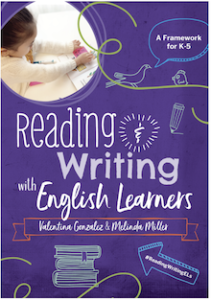An ELA Framework for English Learners
Reading & Writing with English Learners: A Framework for K-5
By Valentina Gonzalez and Melinda Miller
(Seidlitz Education, 2020 – Learn more)
Reviewed by Emily Francis


Reading and writing lessons were not structured in a way that students’ background and home language were maximized. This lack of opportunities and modalities to demonstrate what I was able to do in class just made me feel like an outsider and without a sense of belonging.
So reading a professional development book that is centered around the whole child – and also provides ideas to weave in culturally responsive practices to help English learners grow linguistically – fills my heart with so much joy and hope for ELs.
The educator in me is grateful for a book that not only validates my pedagogy throughout but also provides new ways to help me grow and develop as I learn to teach reading and writing through a language lens.
An opportunity to flex your thinking
If you are looking for a packaged program or scripted curriculum, this is NOT your book. If you are ready to flex your thinking and teaching to help your ELs grow linguistically and as readers and writers, this book offers a structure and an approach to literacy that is research-based, doable, and very effective.
Nine chapters guide teachers in implementing a balanced approach to literacy that centers around building ELs’ linguistic repertoire. Each chapter follows the same structure, models routines, and uses familiar language for the reader to follow. The way each chapter is structured speaks volumes about the way we should structure our reading and writing lessons for ELs.
In each chapter the authors clearly explain what each component of the approach is, what it is not, the benefits for ELs, ways to accommodate for ELs, class scenarios, what experts say, frequently asked questions, and a lesson map. As you read through the chapters, there’s anticipation to read what is next because you know the structure the authors are using.
Providing a structure for our ELs
I feel like this is what we need to do for our ELs to keep them hooked and engaged in reading and writing. We need to implement a structure that our students get familiarized with, and as they do, they begin to own their learning. The I Do / We Do / You Do model (the idea that the teacher gradually releases assistance, allowing students to work independently) is a focus throughout the book.
Several states have adopted the workshop teaching model for literacy at the elementary level so this book would be a route to begin implementing reading and writing lessons with a language lens. This approach facilitates explicit instruction and productively provides intentional language learning support.
I see this book being used in PLCs while teachers are planning their K-5 reading and writing lessons. Teachers, coaches, and administrators can benefit from a book that helps teachers follow state standards for reading and writing AND also follow the state standards for English language learners. It is a great way to close any achievement gap.
For teens as well as youngsters
As a high school English as a Second Language teacher, I think the balanced approach to literacy found in Reading & Writing with English Learners is a practical way for us to teach our ELs in middle schools and high schools as well. This book helps me, as a second language acquisition expert, see my instruction from a literacy perspective that will help my ELs grow in literacy skills and language learning. The strategies shared will only enhance our teaching without having to stop doing what we’re doing (unless it is not effective).
The book’s appendixes are amazing! You have access to 15+ activities that are easy to implement, information about phonics, a culturally inclusive BOOKLIST for kids (my favorite), and ideas for remote learning. Once you begin reading the book, you won’t want to stop. Better yet, you’ll begin looking at your lesson plans and figuring out how to fit in all the fresh ideas you’ve gained. At least I did!
Overall, this book is a ★★★★★ book! Reading & Writing with English Learners is a must-have, must-read guide for anyone who is teaching reading and writing to K-12 students.
Astrid Emily Francis is an English as a Second Language teacher at Concord High School in Concord, North Carolina. She serves students in 9th-12th grade with various English proficiency levels. Emily’s experience as an English Language Learner inspired her to become an ESL teacher and affords her a deep understanding of the challenges her students must overcome to find success. Emily earned a BA in Spanish and a MAT in ESL from UNC-Charlotte.



































